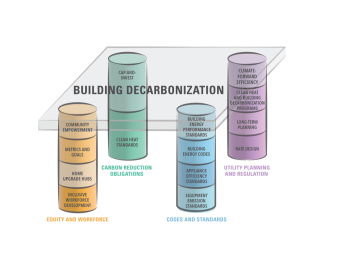Decarbonizing buildings is essential to achieving broader climate goals, which demand rapid progress toward economy-wide decarbonization. Getting there will require thoughtful policy approaches, as building decarbonization involves actions by thousands of individual building owners, as well as installers, builders, distributors, retailers, manufacturers, and energy providers.
No single policy will suffice—rather, a whole suite of actions will be required across the supply chain. States, in particular, have an important role to play in catalyzing a just transition to decarbonized buildings; states establish building energy codes, regulate emissions under state and federal air quality laws, and oversee energy providers, such as electric and gas utilities.
The first part of this brief presents a comprehensive policy framework for states to advance building decarbonization. It describes four key policy areas, which can be thought of as legs of a table for effectively supporting building decarbonization. The second part presents case studies and outlines key principles to guide state decisionmakers as they consider specific policy options and develop a comprehensive strategy for setting their own building decarbonization table.

